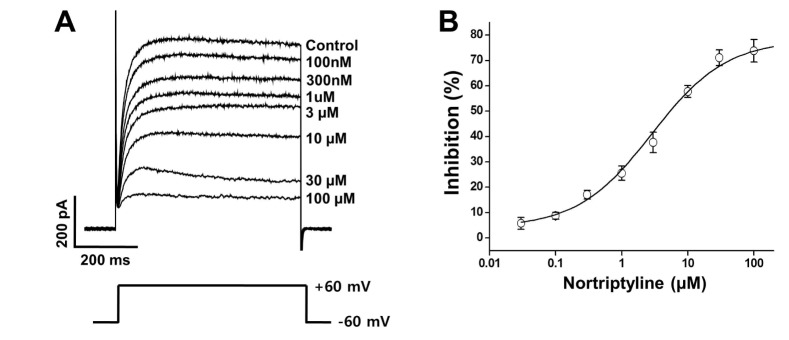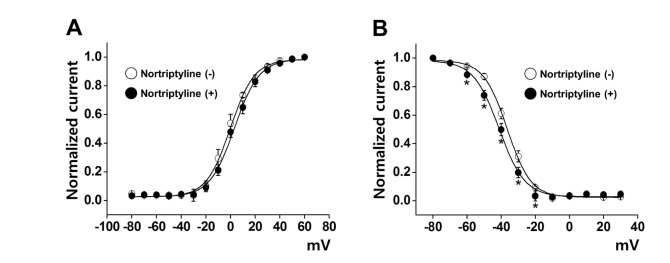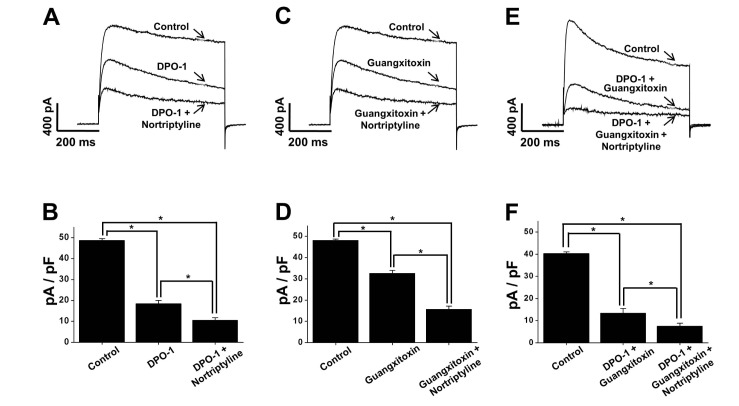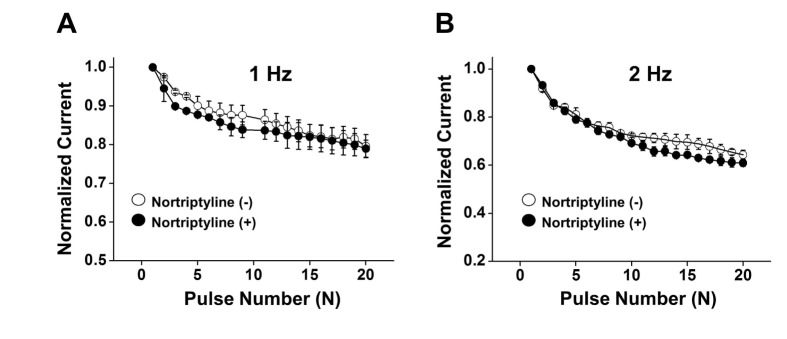1. van den Broek WW, Mulder PG, van Os E, Birkenhäger TK, Pluijms E, Bruijn JA. Efficacy of venlafaxine compared with tricyclic antidepressants in depressive disorder: a meta-analysis. J Psychopharmacol. 2009; 23:708–713. PMID:
18562424.

2. von Wolff A, Hölzel LP, Westphal A, Härter M, Kriston L. Selective serotonin reuptake inhibitors and tricyclic antidepressants in the acute treatment of chronic depression and dysthymia: a systematic review and meta-analysis. J Affect Disord. 2013; 144:7–15. PMID:
22963896.

3. Molyneaux E, Howard LM, McGeown HR, Karia AM, Trevillion K. Antidepressant treatment for postnatal depression. Cochrane Database Syst Rev. 2014; (9):CD002018. PMID:
25211400.

4. Pomara N, Shao B, Choi SJ, Tun H, Suckow RF. Sex-related differences in nortriptyline-induced side-effects among depressed patients. Prog Neuropsychopharmacol Biol Psychiatry. 2001; 25:1035–1048. PMID:
11444676.

5. Nelson MT, Quayle JM. Physiological roles and properties of potassium channels in arterial smooth muscle. Am J Physiol. 1995; 268:C799–C822. PMID:
7733230.

6. Standen NB, Quayle JM. K
+ channel modulation in arterial smooth muscle. Acta Physiol Scand. 1998; 164:549–557. PMID:
9887977.
7. Ko EA, Han J, Jung ID, Park WS. Physiological roles of K
+ channels in vascular smooth muscle cells. J Smooth Muscle Res. 2008; 44:65–81. PMID:
18552454.

8. Ko EA, Park WS, Firth AL, Kim N, Yuan JX, Han J. Pathophysiology of voltage-gated K
+ channels in vascular smooth muscle cells: modulation by protein kinases. Prog Biophys Mol Biol. 2010; 103:95–101. PMID:
19835907.
9. Bae H, Lee D, Kim YW, Choi J, Lee HJ, Kim SW, Kim T, Noh YH, Ko JH, Bang H, Lim I. Effects of hydrogen peroxide on voltage-dependent K
+ currents in human cardiac fibroblasts through protein kinase pathways. Korean J Physiol Pharmacol. 2016; 20:315–324. PMID:
27162486.
10. Bae YM, Kim A, Kim J, Park SW, Kim TK, Lee YR, Kim B, Cho SI. Serotonin depolarizes the membrane potential in rat mesenteric artery myocytes by decreasing voltage-gated K
+ currents. Biochem Biophys Res Commun. 2006; 347:468–476. PMID:
16828462.
11. Archer SL, London B, Hampl V, Wu X, Nsair A, Puttagunta L, Hashimoto K, Waite RE, Michelakis ED. Impairment of hypoxic pulmonary vasoconstriction in mice lacking the voltage-gated potassium channel Kv1.5. FASEB J. 2001; 15:1801–1803. PMID:
11481235.

12. Cox RH, Folander K, Swanson R. Differential expression of voltage-gated K
+ channel genes in arteries from spontaneously hypertensive and Wistar-Kyoto rats. Hypertension. 2001; 37:1315–1322. PMID:
11358947.
13. Liu Y, Terata K, Rusch NJ, Gutterman DD. High glucose impairs voltage-gated K
+ channel current in rat small coronary arteries. Circ Res. 2001; 89:146–152. PMID:
11463721.
Snyders DJ., Yeola SW. Determinants of antiarrhythmic drug action. Electrostatic and hydrophobic components of block of the human cardiac hKv1.5 channel. Circ Res. 1995. 77:575–583. PMID:
7641327.
15. Park WS, Ko JH, Kim N, Son YK, Kang SH, Warda M, Jung ID, Park YM, Han J. Increased inhibition of inward rectifier K
+ channels by angiotensin II in small-diameter coronary artery of isoproterenol-induced hypertrophied model. Arterioscler Thromb Vasc Biol. 2007; 27:1768–1775. PMID:
17525364.
16. Malmgren R, Aberg-Wistedt A, Bertilsson L. Serotonin uptake inhibition during treatment of depression with nortriptyline caused by parent drug and not by 10-hydroxymetabolites. Psychopharmacology (Berl). 1987; 92:169–172. PMID:
2440073.

17. Watts SW. 5-HT in systemic hypertension: foe, friend or fantasy? Clin Sci (Lond). 2005; 108:399–412. PMID:
15831089.

18. Pomara N, Shao B, Choi SJ, Tun H, Suckow RF. Sex-related differences in nortriptyline-induced side-effects among depressed patients. Prog Neuropsychopharmacol Biol Psychiatry. 2001; 25:1035–1048. PMID:
11444676.

19. Su S, Ohno Y, Lossin C, Hibino H, Inanobe A, Kurachi Y. Inhibition of astroglial inwardly rectifying Kir4.1 channels by a tricyclic antidepressant, nortriptyline. J Pharmacol Exp Ther. 2007; 320:573–580. PMID:
17071817.

20. Terstappen GC, Pula G, Carignani C, Chen MX, Roncarati R. Pharmacological characterisation of the human small conductance calcium-activated potassium channel hSK3 reveals sensitivity to tricyclic antidepressants and antipsychotic phenothiazines. Neuropharmacology. 2001; 40:772–783. PMID:
11369031.

21. Yamakawa Y, Furutani K, Inanobe A, Ohno Y, Kurachi Y. Pharmacophore modeling for hERG channel facilitation. Biochem Biophys Res Commun. 2012; 418:161–166. PMID:
22244872.

22. Bardai A, Amin AS, Blom MT, Bezzina CR, Berdowski J, Langendijk PN, Beekman L, Klemens CA, Souverein PC, Koster RW, de Boer A, Tan HL. Sudden cardiac arrest associated with use of a non-cardiac drug that reduces cardiac excitability: evidence from bench, bedside, and community. Eur Heart J. 2013; 34:1506–1516. PMID:
23425522.

23. Hong DH, Li H, Kim HS, Kim HW, Shin SE, Jung WK, Na SH, Choi IW, Firth AL, Park WS, Kim DJ. The effects of the selective serotonin reuptake inhibitor fluvoxamine on voltage-dependent K
+ channels in rabbit coronary arterial smooth muscle cells. Biol Pharm Bull. 2015; 38:1208–1213. PMID:
26235584.

24. Kim HW, Li H, Kim HS, Shin SE, Jung WK, Ha KS, Han ET, Hong SH, Choi IW, Park WS. Cisapride, a selective serotonin 5-HT4-receptor agonist, inhibits voltage-dependent K
+ channels in rabbit coronary arterial smooth muscle cells. Biochem Biophys Res Commun. 2016; 478:1423–1428. PMID:
27569285.
25. Lee HM, Hahn SJ, Choi BH. Blockade of Kv1.5 by paroxetine, an antidepressant drug. Korean J Physiol Pharmacol. 2016; 20:75–82. PMID:
26807026.

26. Lee HM, Hahn SJ, Choi BH. Blockade of Kv1.5 channels by the antidepressant drug sertraline. Korean J Physiol Pharmacol. 2016; 20:193–200. PMID:
26937216.

27. Xu C, Lu Y, Tang G, Wang R. Expression of voltage-dependent K
+ channel genes in mesenteric artery smooth muscle cells. Am J Physiol. 1999; 277:G1055–G1063. PMID:
10564112.
28. Yuan XJ, Wang J, Juhaszova M, Golovina VA, Rubin LJ. Molecular basis and function of voltage-gated K
+ channels in pulmonary arterial smooth muscle cells. Am J Physiol. 1998; 274:L621–L635. PMID:
9575881.
29. Lagrutta A, Wang J, Fermini B, Salata JJ. Novel, potent inhibitors of human Kv1.5 K
+ channels and ultrarapidly activating delayed rectifier potassium current. J Pharmacol Exp Ther. 2006; 317:1054–1063. PMID:
16522807.
30. Zhao N, Dong Q, Du LL, Fu XX, Du YM, Liao YH. Potent suppression of Kv1.3 potassium channel and IL-2 secretion by diphenyl phosphine oxide-1 in human T cells. PLoS One. 2013; 8:e64629. PMID:
23717641.

31. Moral-Sanz J, Gonzalez T, Menendez C, David M, Moreno L, Macias A, Cortijo J, Valenzuela C, Perez-Vizcaino F, Cogolludo A. Ceramide inhibits Kv currents and contributes to TP-receptor-induced vasoconstriction in rat and human pulmonary arteries. Am J Physiol Cell Physiol. 2011; 301:C186–C194. PMID:
21490312.

32. Tsvetkov D, Tano JY, Kassmann M, Wang N, Schubert R, Gollasch M. The role of DPO-1 and XE991-sensitive potassium channels in perivascular adipose tissue-mediated regulation of vascular tone. Front Physiol. 2016; 7:335. PMID:
27540364.

33. Jensen BP, Roberts RL, Vyas R, Bonke G, Jardine DL, Begg EJ. Influence of ABCB1 (P-glycoprotein) haplotypes on nortriptyline pharmacokinetics and nortriptyline-induced postural hypotension in healthy volunteers. Br J Clin Pharmacol. 2012; 73:619–628. PMID:
21999196.

34. Quayle JM, Dart C, Standen NB. The properties and distribution of inward rectifier potassium currents in pig coronary arterial smooth muscle. J Physiol. 1996; 494:715–726. PMID:
8865069.










 PDF
PDF ePub
ePub Citation
Citation Print
Print


 XML Download
XML Download